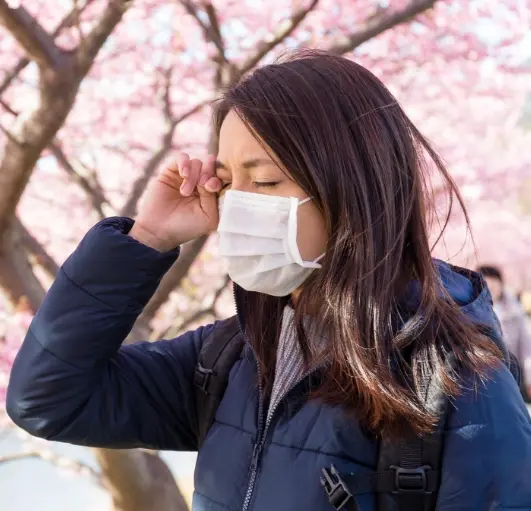Dry Eye
Dry eye occurs when the quantity and/or quality of tears fails to keep the surface of the eye adequately lubricated. This is a very common condition, with about 30% of Canadians experiencing it.
The risk of developing dry eye increases with age as your tear production decreases. Dry eye tends to affect women more than men.
Other risk factors include:
- Autoimmune Disorders.
- Certain Medication's Side Effects.
- Windy Or Dry Environments.
- Rosacea Or Blepharitis.
- Seasonal Allergies.

Tears consist of three layers: oil, water and mucus. Each component protects and nourishes the front surface of the eye. A smooth oil layer helps prevent evaporation of the water layer, while the mucin layer spreads the tears evenly over the eye's surface. If the tears evaporate too quickly or do not spread evenly over the cornea due to deficiencies with any of the three tear layers, dry eye symptoms can develop.
Symptoms Of Dry Eye
- A Stinging, Burning Or Scratchy Sensation In Your Eyes.
- Stringy Mucus In Or Around Your Eyes.
- Sensitivity To Light.
- Eye Redness.
- A Sensation Of Having Something In Your Eyes.
- Difficulty Wearing Contact Lenses.
- Difficulty With Nighttime Driving.
- Watery Eyes, Which Is The Body's Response To The Irritation Of Dry Eyes.
- Blurred Vision Or Eye Fatigue.
Treatment For Dry Eyes
Home Remedies
For mild dry eyes, there are small changes you can make at home. You can increase your blink rate, take frequent breaks when using computer screens, remove any eye makeup thoroughly, and clean your eyelids.
Artificial Tears
For mild cases of dry eyes, the best treatment may be the frequent use of artificial tears or other lubricating eye drops. Artificial tears usually are the first step in dry eye treatment. Many brands of artificial tears are available without a prescription. You may need to try a few different kinds until you find one that works well for you.
Restasis
If artificial tears are not providing enough relief, your eye doctor might recommend the daily use of a prescription eye drop called Restasis for your dry eye treatment.
Restasis does more than simply lubricate the surface of your eye. It includes an agent that reduces inflammation associated with dry eye syndrome and helps your body produce more natural tears to keep your eyes moist, comfortable and healthy. The effect of Restasis is not immediate. You must use the drops daily for a minimum of 90 days to experience the full benefits of this dry eye treatment.
Steroid Eye Drops
Inflammation in the eyes can cause dry eye. Therefore, your doctor may prescribe steroid eye drops to combat the inflammation. You can use steroid eye drops in conjunction with Restasis and artificial tears. Steroid drops are generally a short-term solution, and prolonged use can increase your risk of increased intraocular pressure or cataracts.
Punctal Plugs
A punctal plug is a small, sterile device inserted into one of the small openings (puncta) of tear drainage ducts. The tear drainage ducts are located in the inner corner of the upper and lower eyelids. With these in place, your tears will stay on the surface of your eye for longer and eventually evaporate. Dissolving plugs or permanent plugs are available through our office. Alberta Health does not cover these plugs. The dissolving punctal plugs are $25 per plug, and the permanent ones are $150 per plug.
Meibomian Gland Expression
At the base of your eyelashes, you have meibomian glands that secret oils to preserve your tear film and stop the tears from evaporating too quickly. If these glands are not secreting enough oils or become plugged, this is called meibomian gland dysfunction. Some offices offer a procedure to express these glands by applying significant pressure to the lids. This can be uncomfortable, but sometimes the results can be worth this short-term discomfort. Currently, our office is not offering this service.
Warm Compresses
An alternative (and potentially more comfortable) way to help open clogged meibomian glands to treat dry eyes is to apply warm compresses to the closed eyelids. A warm compress will soften the hardened meibum. This needs to be done for a minimum of 10 minutes at a temperature of 42℃. Apply twice a day for the best results.
Lipiflow
This is an in-office treatment offered by some doctors that combines warm compresses and expression of the meibomian glands. It is a costly procedure and is usually around $700-$900 per eye. Our office does not have the equipment for this procedure, but it can be an option for you at other locations.
Nutritional Supplements
Our doctors recommend nutritional supplements as part of a dry eye treatment plan. Studies have found that supplements containing omega-3 fatty acids can decrease dry eye symptoms. Some good sources of omega-3's include cold-water fish such as salmon, sardines, herring and cod. For a vegetarian source of omega-3s, you can try flaxseed oil to relieve dry eyes. Contact us for more information.